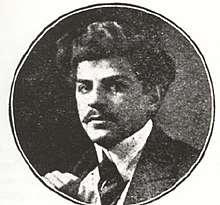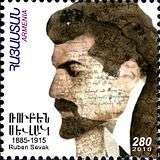Ruben Sevak
Rupen Çilingiryan (Sevag) (Ռուբէն Յովհաննէսի Չիլինկիրեան (Սեւակ), February 28, 1886, Silivri, Ottoman Empire – August 26, 1915, Çankırı, Ottoman Empire) was an Armenian poet, prose-writer, and doctor.[1][2]
Rupen Çilingiryan (Sevag) Ռուբէն Սեւակ | |
|---|---|
 | |
| Born | February 15, 1885 Silivri, Ottoman Empire |
| Died | August 26, 1915 (aged 30) Çankırı, Ottoman Empire |
| Occupation | poet, prose-writer, and doctor. |
Biography
Rupen Sevak received his elementary education in his birthplace at the Askanazian school. He then moved to Constantinople (now Istanbul) and studied at the prestigious Berberian School. He graduated in 1905 and went to Lausanne, Switzerland, to pursue studies at the medical school. He met there his future wife, Helene Apell.[3] After graduating in 1911, he decided to go back to Constantinople in 1914 with his family. This decision would cost him his life. He was arrested on at the onset of the Armenian Genocide on April 24, 1915 and killed on August 26, 1915.[1][2]

Creative poet
Sevag's first poem was printed in 1905. Sevag is mostly known as a lyric poet. He also composed many love songs, highly acclaimed for their feeling and depth. His poetry was characterized by freshness and precision of language, and noted for its varying meter and its musicality. His poetry captures the history and essence of Western Armenian literature while creating a totally new genre.
References
| Armenian Wikisource has original text related to this article: |
- Hacikyan, Agop; Gabriel Basmajian; Edward S. Franchuk (2005). Nourhan Ouzounian (ed.). The Heritage of Armenian Literature Volume III: From the Eighteenth Century to Modern Times. Detroit, MI: Wayne State University Press. p. 1072. ISBN 0-8143-2815-6. Retrieved 19 October 2011.
- Gregoire Balakian: Le Golgotha arménien, Le cercle d'écrits caucasiens, La Ferté-Sous-Jouarre 2002 (vol. 1) ISBN 2-913564-08-9 pp. 442
- Der Dichter und seine Frau. Deutsch-Armenische Gesellschaft. ADK 139, p. 46-48